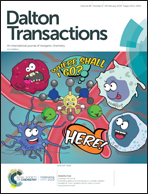Anion-mediated bio-relevant catalytic activity of dinuclear nickel(ii) complexes derived from an end-off compartmental ligand†
Abstract
Four dinuclear nickel(II) complexes, namely [Ni4(L)2(H2O)8(μ2-H2O)2](NO3)6(H2O)6 (1), [Ni2(L)Cl2(μ-Cl)(CH3OH)] (2), [Ni2(L)(OAc)2(H2O)2]Br (3) and [Ni2(L)(H2O)4(μ2-OH)] (H2O)X(I)X (4), have been synthesized using a template synthesis technique by adding nickel(II) salts (nitrate/chloride/bromide/iodide) to the N4O donor end-off compartmental ligand (HL) obtained via the condensation of 2-(2-pyridyl)ethylamine and 2,6-diformyl-4-isopropyl phenol in methanol. All complexes were characterized with the help of typical physicochemical techniques, and their solid-state structures were assigned from single crystal X-ray analysis. The variable temperature magnetic study reveals that the two nickel centers are antiferromagnetically coupled with J values ranging from −5 to −15 cm−1 in the complexes. The catecholase-like activity of complexes 1–4 was studied using 3,5-di-tert-butylcatechol (3,5-DTBC) as the model substrate in N,N-dimethylformamide (DMF) medium. Complex 1 shows the catecholase activity, while the other complexes were found to be inactive. The phosphatase-like activity of the complexes was also investigated in a 97.5% (v/v) DMF–water mixture using the disodium salt of 4-nitrophenylphosphate (4-NPP) as the model substrate and the reactivity trend was 4 > 1 > 3 > 2. The reasons behind the activity, inactivity and activity trend have been explored. It has been assumed that the anions associated with the complexes are supposed to play a crucial role in the whole event. Complex 1 showed catalytic promiscuity, whereas complexes 2, 3 and 4 should be considered only as the potential hydrolytic catalyst.



 Please wait while we load your content...
Please wait while we load your content...